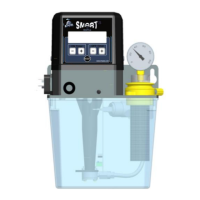5
6.2 AUTOMATIC VERSION
The Automatic version of the pump is equipped with a built in electronic
controller that controls the pump and monitors feedback from the pressure
and level switches.
The control system settings and human interface is via the 16x2 character LCD
display on the front face and the 5 programming buttons. A Reset button is
located on the lower left side.
The Manual cycle button present on the Manual version remains but on the
Automatic version will cause the local built in control system to run a
lubrication cycle.
SMART3 automatic pumps can be programmed to operate withintermittent
lubricationcycle that involves the following three phases:
A) Prelube -> pre- lubrication when system is powered on
B) Lube (lube – wait) ->the lubrication cycle
C) Standby
A)PRELUBE
The pre-lube phaseallows the user to run a set number of lubrication cycles
(250 Max) when the pump is powered on. This typically is used when a
system needs additional quantities of oil on power up.
Prelube takes place:
- on POWER-ON;
- on RESET;
- Any time new parameters are set.
When prelube is set to “0”, the prelube phase is completed skipped and the
pump will work just with the normal lube and standby phases.
B) LUBE
This step is made up of a set of cycles (max 999
cycles) during which lubrication is carried out.
Each cycle consists of two sub-cycles (lube and
wait) and involves the monitoring of timers
and/or inputs:
- Duringlube, system delivers lubricant to the
lubrication points;
- Duringwait, a timer defines the wait time
between two or more lube cycles or before the
beginning of the standby phase (in case only 1
lube cycle was set).
There are two types of lube:
TIMER: The pump will simply run for the On time
and then enter standby mode;
PS: The pump will run until the pressure switch is made and pressure is maintained for a check period. Subsequently, the
pump will be switched off and the standby phase will commence.
C) STANDBY
During this step lubrication system is idle until the next lubrication cycle. There are three ways to regulate standby:
TIMER: a timer regulate system idling;
PULSE: a pulse counter regulate system idling;
BOTH: both a timer and a pulse counter regulate system idling. The type of standby will depend on which of these two
events will start first.
For conditions of use and programming cycles see chapter 8.
Lubrication Cycle can be repeated up to
250 times.
Lubrication Phase can comprise of many Lubrication Cycles

